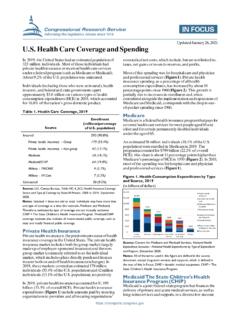Transcription of Government in markets
1 Government in marketsWhy competition matters a guide for policy makers Crown copyright 2009 This publication (excluding the OFT logo) may be reproduced free of charge in any format or medium provided that it is reproduced accurately and not used in a misleading context. The material must be acknowledged as Crown copyright and the title of the publication Page1 Executive summary 1 Part A: Principles 32 Introduction 43 The role of competition 64 Reasons for intervention 105 Types of intervention 146 Key points for policy makers 16 Part B: Government interventions 217 Regulation 228 Subsidies and taxation 269 Government as an influencer 3110 Government as a market maker 3411 Public procurement 3712 Government as a supplier 41 AnnexeA A brief guide to competition and consumer law 43B References 46 One of the Office of Fair Trading s functions, under section 7 of the Enterprise Act 2002, is to provide information and advice to Government on competition and consumer issues.
2 As such, we have a dedicated Advocacy Team whose role is to strengthen our relationships with Government departments and other stakeholders to help preserve and promote competition in markets and to increase awareness of consumer protection issues. This includes ensuring that regulation does not unnecessarily or disproportionately restrict competition, but instead achieves the best possible outcomes for consumers. The aim of this guide is to provide a framework for analysing Government s interaction with markets , and for policy makers who want to understand the different ways in which Government can affect markets . It may also help provoke a more open debate about the long term effects of Government intervention, both positive and in markets1.
3 Executive summaryThis guide sets out the rationale for Government intervention in markets and demonstrates that for these interventions to be effective in the long term, their impact on competition needs to be a central consideration. The guide then sets out some of the major ways that Government intervenes, both in setting market frameworks and through its wider impact on markets . It also identifies ways that policy makers can spot and minimise unintended consequences that impact on effective market dynamics beyond the short term. It includes case studies of the impacts in s role in marketsGovernment can affect markets either through direct participation (as a market maker or as a buyer or supplier of goods and services), or through indirect participation in private markets (for example, through regulation, taxation, subsidy or other influence).
4 Government frequently has a choice between traditional instruments and market-based approaches. There are pros and cons associated with all types of Government intervention. Many, if not most, intervention can have unforeseen consequences. Failure to address indirect costs and possible spillovers can result in a less effective policy and impose unnecessary economic their most basic, markets are a mechanism for allocating resources. Well-regulated, competitive markets can maximise consumer welfare, and, by raising economic growth, also increase total welfare. When markets work well, firms thrive by providing what consumers want better and more cost-effectively than their competitors.
5 As such, effective competition provides significant benefits for consumers through greater choice, lower prices, and better quality goods and services. Competition also provides strong incentives for firms to be more efficient and innovative, thereby helping raise productivity growth across the economy. Left to their own devices, however, markets will not necessarily deliver the best outcomes for consumers, companies or Government . In order to address this, Government sets legal and institutional frameworks for markets and companies to operate in. That is, it puts in place rules and regulations that determine appropriate conduct of firms and individuals, and the institutions necessary for enforcing them.
6 markets thus do not exist independently of Government , which has a legitimate role in intervening in and shaping them. Government also intervenes more widely in markets to achieve other policy goals and correct market failures. The way in which it chooses to do so, however, is crucial to both the effectiveness of its interventions and their of Fair Tradingless transparent than other measures such as setting product standards or introducing taxes or subsidies. While these may also have effects on competition, they can typically be designed in a more focused and transparent major challenge for policy makers is in identifying the hidden costs of competition restrictions.
7 While the policy benefits of particular interventions may be clear, the longer-term effects on competition can be far harder to intervention can also inadvertently benefit regulated industry rather than the wider public (regulatory capture), promote inefficiency because of restricted competition or underplay the role of consumers by concentrating purely on the supply-side of the general, measures that directly limit competition in the market will not be the best instruments. Regulation of, for example, price, entry and exit, or allowing anti-competitive mergers and agreements between firms, are generally rather blunt measures and can be At a minimum, the aim for policy makers should be to minimise the distortions to markets , subject to achieving the desired policy objective.
8 That is, where Government has a reason for intervening in markets , it should try to do so in a way that avoids unintended consequences as far as possible. In assessing the effectiveness of existing or proposed Government interventions in a market, policy makers should consider the associated costs and benefits, including the impact on competition within a market. Some interventions are more likely to distort or restrict competitive markets , either intentionally or inadvertently. To identify these, policy makers should consider the following questions: Does the intervention affect the possibility of entry and exit in a market for example by granting exclusive rights to supply, limiting the number of suppliers, or significantly raising the cost to new firms of entering the market?
9 Does it affect the nature of competition between firms in a market, either through direct restrictions (such as price or product regulation) or by reducing the incentive for firms to compete strongly? Does it affect the ability of consumers to shop around between firms and exercise choice for example, does it raise costs of switching?When a proposed intervention is likely to adversely affect competitive markets , policy makers should consider possible alternatives which might be less restrictive of competition. Government can often play a beneficial role in stimulating competition in markets , either through setting up market mechanisms, or, for example, through its wider role in procurement.
10 Key points for policy makers:3 Government in marketsPart A: Principles4 Office of Fair Trading41 HMT (2009a), pages 231 and Introductionand broadband cables) as well as investment in innovation and education. Government has also intervened to help the economy respond to longer term challenges such as energy and climate change through, for example, providing subsidies for renewable energy production. Government 's more active role in markets coincides with a need to spend carefully. The 2009 Budget estimated that between 2007/08 and 2009/10 Government expenditure will have increased by 15 per cent, while tax receipts will have fallen by 10 per Any intervention needs to be well designed and fit for purpose to ensure that the highest value for money can be achieved and that damaging unintended consequences are may mean a renewed focus on the delivery of public services, such as healthcare, education or benefits, which have traditionally been provided directly by the public sector through an actual or near the same time.














